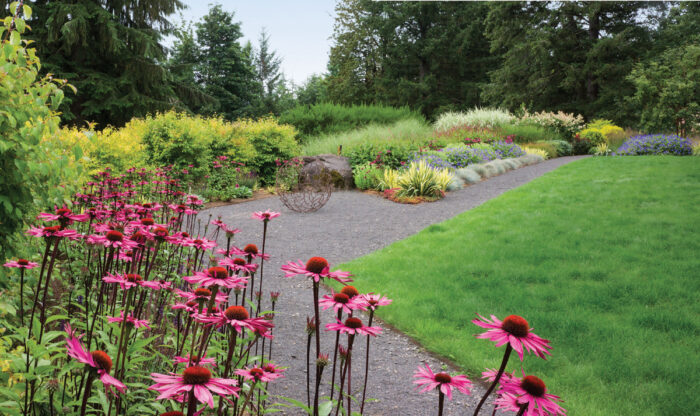
When I first visited this property in the winter of 2010, I was immediately smitten by the site, and the possibilities began to percolate in my mind’s eye. My clients had built a beautiful, contemporary home in a clearing, with wide open views to the surrounding forest. The house is surrounded by a productive blueberry farm, pastures for livestock, and outbuildings to support the farm.
Big properties call for big ideas, and all too often they require big budgets in order to implement a grand concept. Over the next several years, we were able to facilitate this magical transformation without elaborate and expensive hardscape changes to the site. We did this by letting plants take center stage.
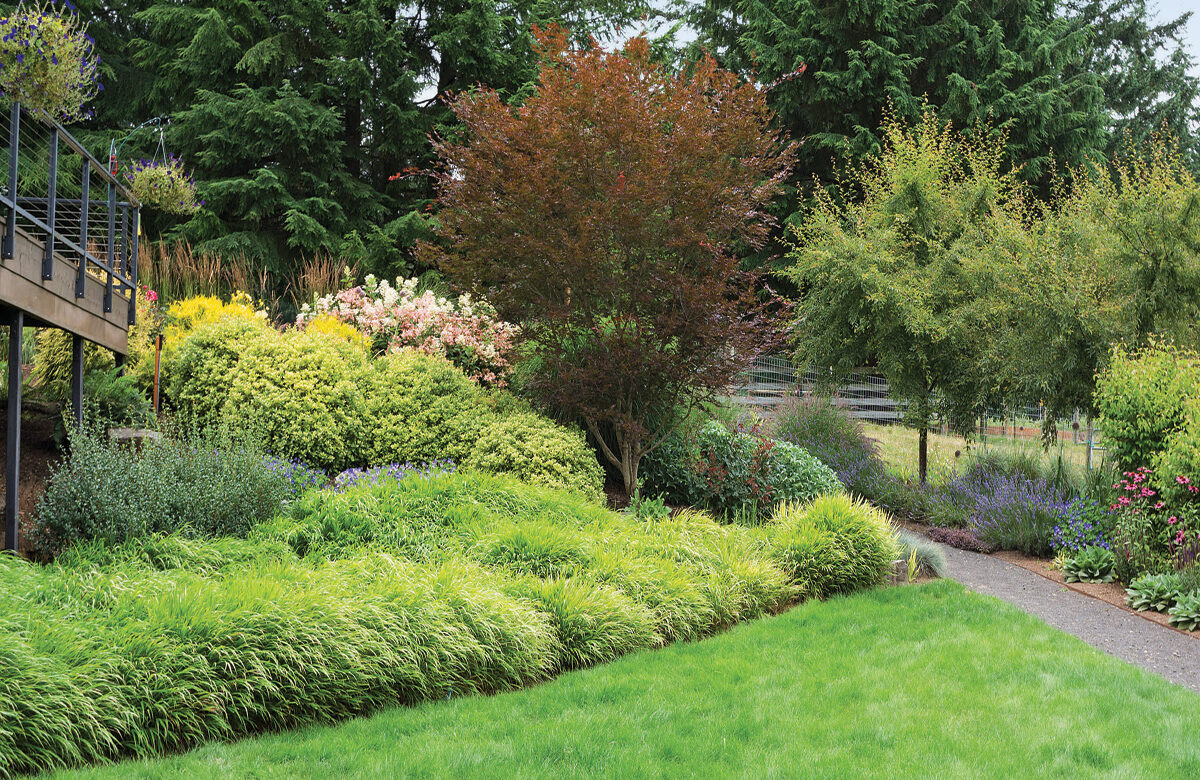
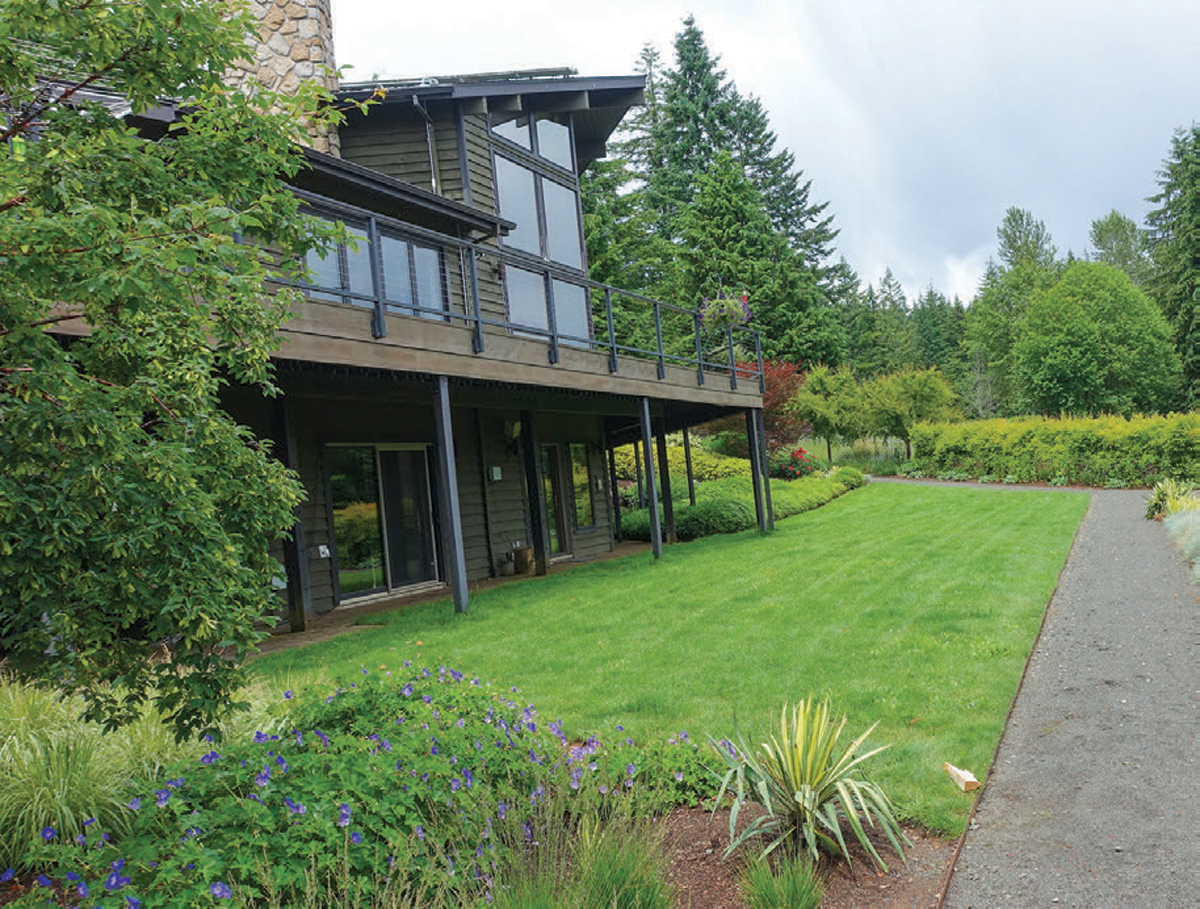
From that first visit, the lines of the house have been very evocative for me. From the upper deck, I felt as if I were perched at the prow of a ship moving full steam ahead into the wild, natural spaces.
The centerpiece of the garden, what I call the contemporary meadow, is situated behind and below the house. Viewed from above, it became the dominant concept for the entire garden. Our plan called for a naturalistic garden that would sync to the wide open spaces while giving a nod to the contemporary lines of the home. By reflecting these lines onto the garden, they became a grounding influence and the centralized theme that brought a sense of order and cohesion to the overall garden.
Know your lines
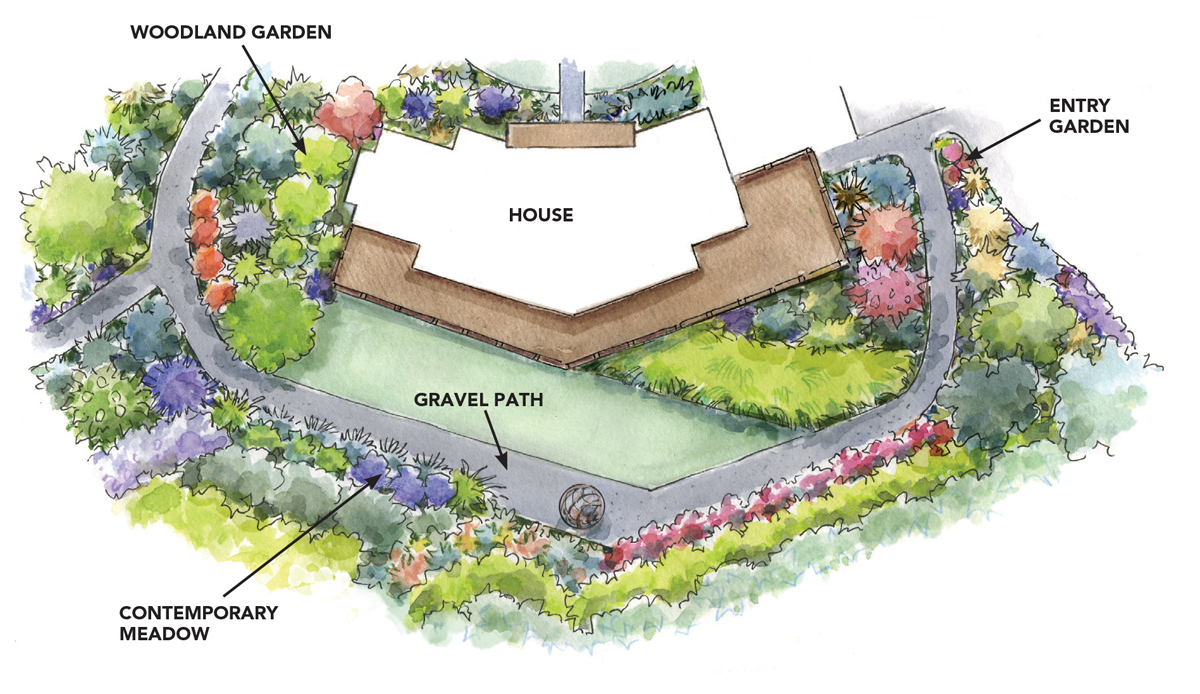
The “living lines” created by the arrangement of plants not only connects the house to the landscape, but it also adds a unique flair given the garden’s naturalistic surroundings. Using large numbers of the same or similar plants also helps keep maintenance to a minimum.
Early on, I learned that my client loved the look and feel of grasses. This was a great discovery, because they were a perfect match for the job at hand. We set out to create a garden with simple hardscape, using gravel paths and steel edging to define the lines of the garden. In addition to being budget friendly, gravel made sense because of its organic, casual vibe.
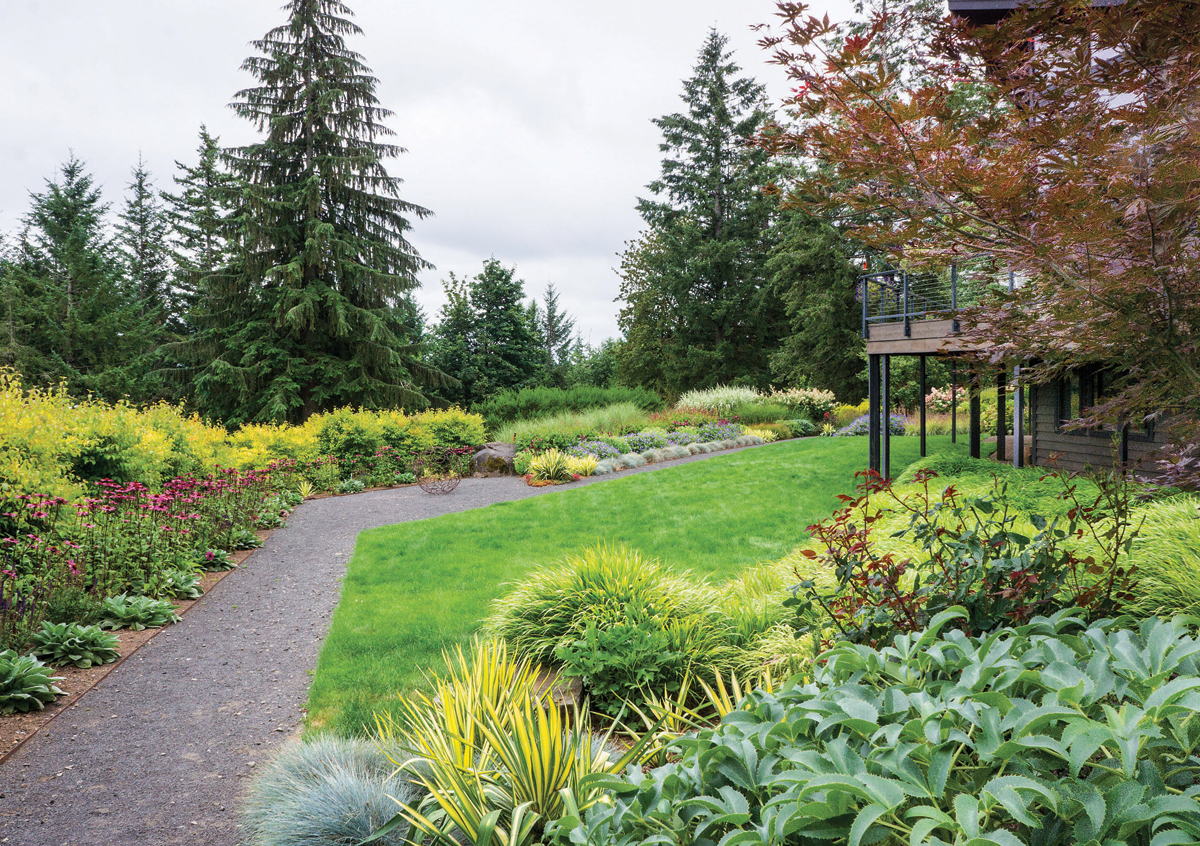
The strong lines of the central path are echoed by a subset of the plants that we used to create living lines. For example, a hedge of ‘Midwinter Fire’ dogwood (Cornus sanguinea ‘Midwinter Fire’, Zones 5-8) borders a long section of the path. Although perhaps most loved for its scrim of fiery stems in winter, ‘Midwinter Fire’ creates a sturdy backdrop that reinforces the linear theme. In another area, a fringe of blue fescue (Festuca glauca and cvs., Zones 4-8) creates a footer for the exuberant mingle of perennials that are backed by a line of ‘Morning Light’ miscanthus (Miscanthus sinensis* ‘Morning Light’, Zones 5-9), and at the very back, a dense hedge of our native California lilac (Ceanothus spp. and cvs., Zones 4-10) signals the edge of our cultivated garden.
Creating a garden of this size requires a diligent screening process. We emphasized achieving that magical and often elusive balance of high-impact, low-maintenance, and multiseason good looks: the holy grail of garden making. Plants needed to pass muster on their own before becoming candidates for the overall palette. More important than including the latest and greatest was selecting plants that would perform. As a result, the garden includes a number of quite common plants.
There are several good reasons for being open to including common plants in your scheme. They’re reliable, predictable, and practical—that’s why they’re common. Also, when you use a large quantity of a single plant, there will always be some that don’t make it, and leaving gaps detracts from the whole. Common plants are widely grown, so they’re readily available, allowing you to plug in any necessary replacements quickly, easily, and inexpensively. Sometimes that means that they’re not obviously remarkable—but paired with the right partner, they can shine.
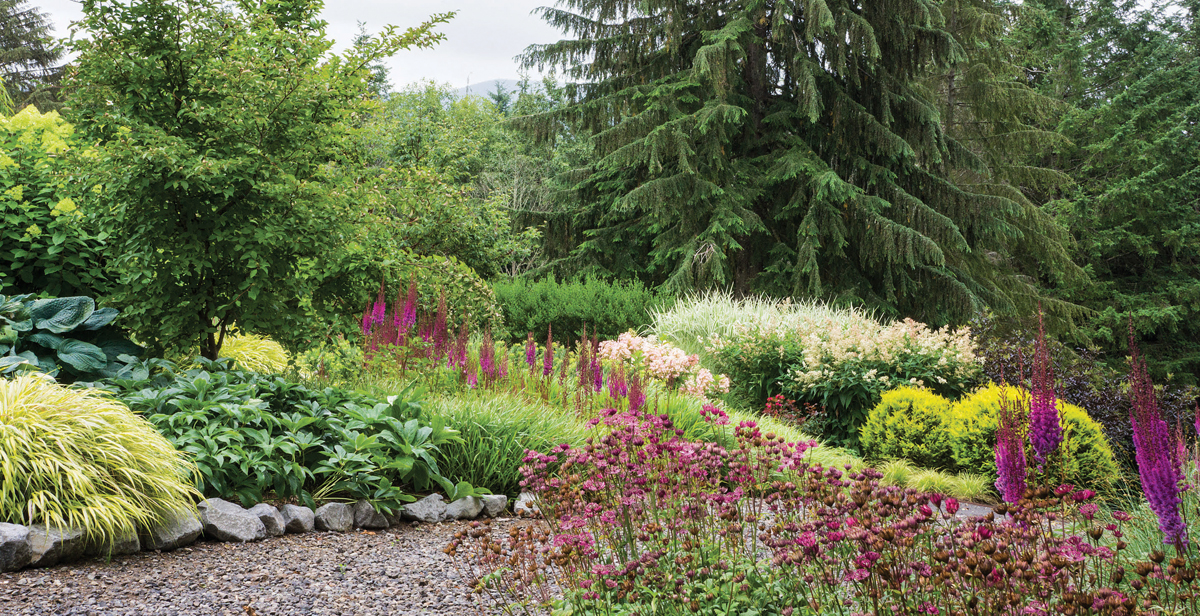
From this perspective, we came up with a finite and carefully curated palette of plants to populate the three main sections in the garden: the entry garden, the woodland garden, and the contemporary meadow. As one moves through the garden, some plants are repeated from one section to the next, a signal to the continuing thread.
Plants selected for their foliage or long season of interest provide a frame for the flowering perennials. In the woodland section of the garden, bands of ‘Duke Gardens’ plum yew (Cephalotaxus harringtonia ‘Duke Gardens’, Zones 6-9) provide a sturdy frame for showy plumes of purple candle astilbe (Astilbe chinensis ‘Purpurkerze’, Zones 4-8) and buttons of ‘Hadspen Blood’ astrantia (Astrantia major ‘Hadspen Blood’, Zones 4-9).
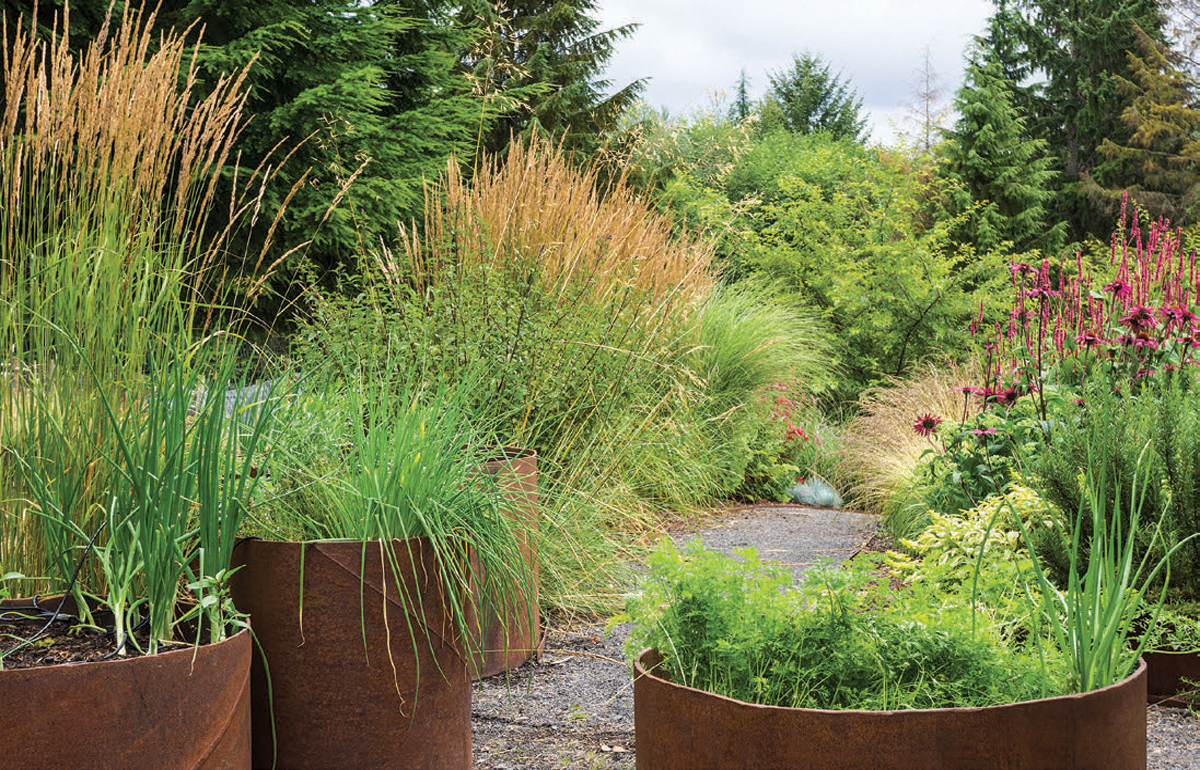
We kept the overall palette of plants as small as we could while achieving the effect we desired. How the garden was going to be maintained was a top consideration, so I chose fewer plants for the client to learn and understand. While low maintenance was a top priority, we approached the design with eyes wide open, knowing full well that no garden is “no maintenance.”
Due to our proximity to natural areas, we avoided plants with known bad habits, and any that might run the risk of becoming invasive were not considered. Daily fussing wasn’t going to happen, so we didn’t include any plants that require deadheading, staking, or any high-touch coddling. We embraced the concept of aging-in-place for the grasses and perennials in our palette, selecting plants for the poise they display in their senescence. Perennials, such as the coneflowers and sedum, and the great swaths of grasses are allowed to age naturally—seed heads are left in place. The reward is that some of the garden’s most memorable moments take place in late fall as the low, fading light illuminates the grasses from behind.
We decided that plants requiring seasonal maintenance blitzes were acceptable. For instance, some tasks, such as cutting back the big grasses, are substantial jobs. But when viewed through the lens that these are done once a year and are the type of projects you can get help with, they become palatable.
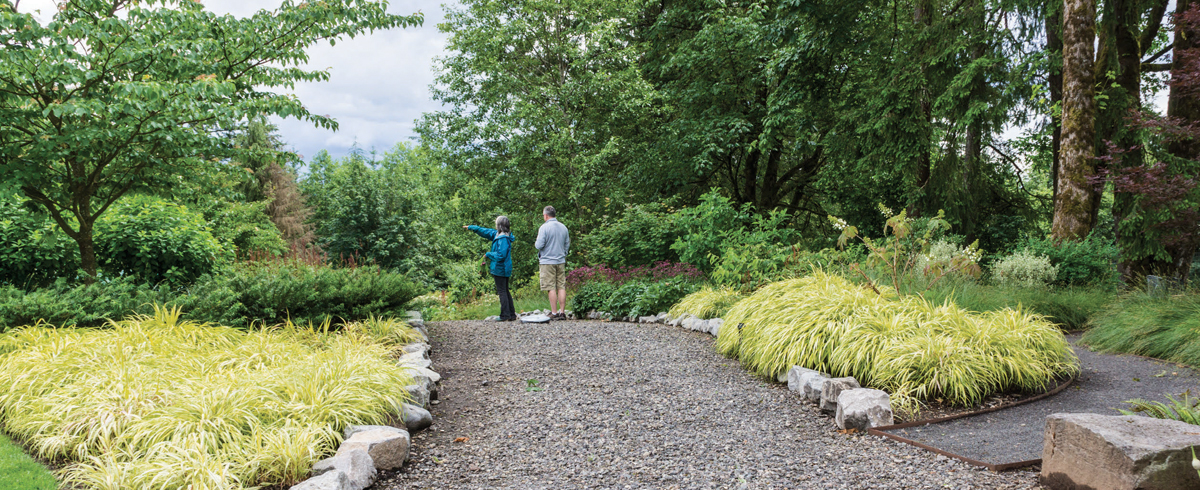
To maintain balance between the perennial players, some need to be checked, others encouraged. For example, ‘Firetail’ persicaria grows quickly and has a tendency to push out the more demure members of the palette, so it’s regularly divided to allow adequate space for others to thrive.
Imposing this discipline doesn’t mean closing the door to options. For example, though we used a number of different grasses, once you get the hang of caring for one, you know the drill for the rest. We used expansive swaths of Japanese forest grass (Hakonechloa macra, Zones 5-9), but we selected two varieties: the straight species and the cultivar ‘Aureola’ (Hakonechloa macra ‘Aureola’, Zones 5-9) for different effects. Using the golden ‘Aureola’ in the large, lawn-like swath would have been too much: too showy, too yellow. But the straight species perfectly conveys what we were going for—a serene, flowing sea of green that moves with the breeze. In another area, masses of yellow light up the woodland floor. Two grasses, same care regimen—this allowed us to achieve effects that are similar but not the same.
The garden has become a source of joy for my clients and all those who visit. A stroll through is an immersive experience, allowing one to enjoy the plantings up close and to commune with the many bees, butterflies, and birds that are frequent visitors. Viewed from above, the underlying pattern that connects home, garden, and the natural setting allows them to coexist in a beautiful and cohesive way. This well-defined outline, these repeated plants, and a consistent color story create a continuing thread. The lines of the garden lead, and our hearts follow.
Common plants, uncommon beauty
In the lower garden, a simple but effective tapestry of four flowering perennials continues the color story begun by the woodland perennials with their shades of pink, purple (light and saturated), and blue. Taken as a whole, they represent a pleasing variety in flower shapes: daisylike blooms of the coneflower; masses of simple five-petal flowers from the geranium; crimson spires of the persicaria; and dense, rounded clusters of the sedum.
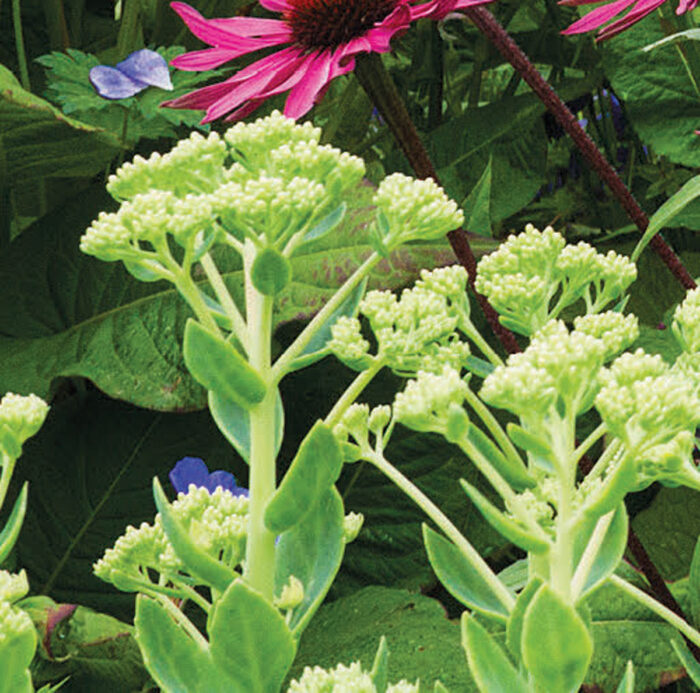 |
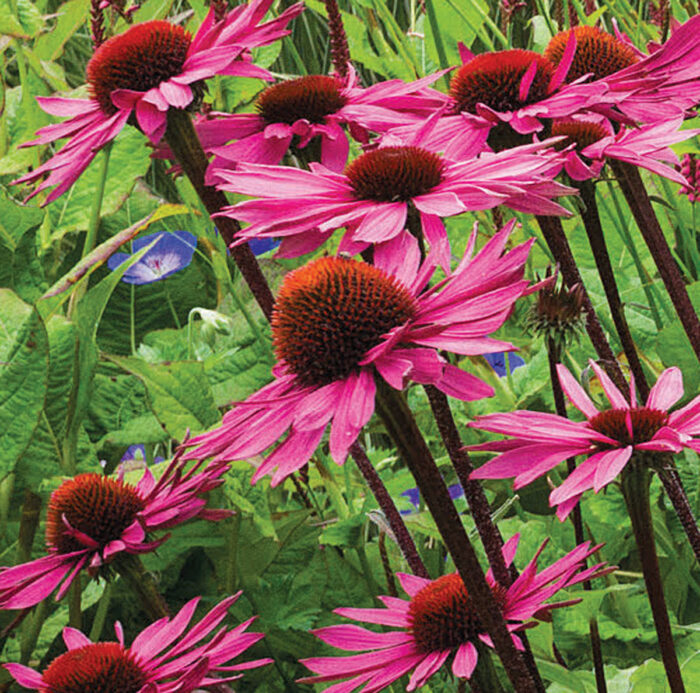 |
Autumn joy sedumName: Hylotelephium ‘Herbstfreude’ Zones: 3-9 Size: 18 to 24 inches tall and wide Conditions: Full sun to partial shade; average to dry, well-drained soil |
‘Merlot’ purple coneflowerName: Echinacea purpurea ‘Merlot’ Zones: 3-9 Size: 2 to 3 feet tall and 1 to 2 feet wide Conditions: Full sun to partial shade; average to dry well-drained soil |
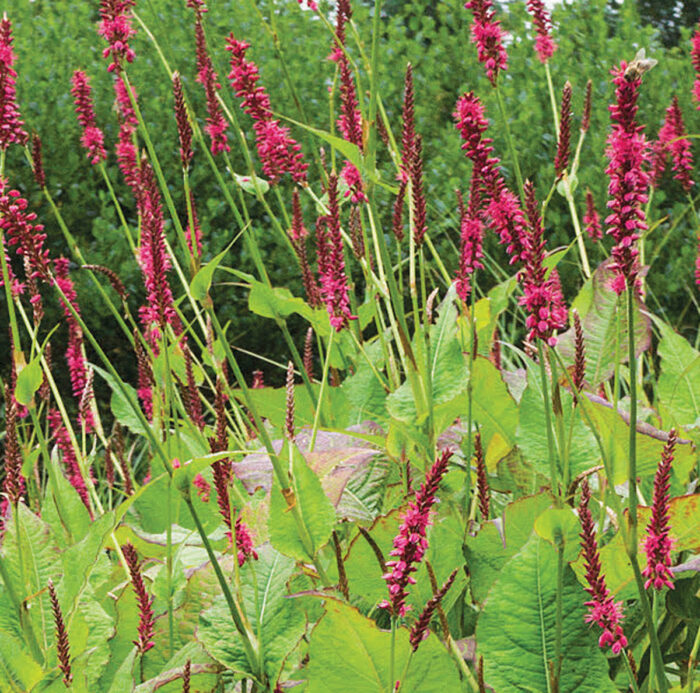 |
 |
‘Firetail’ persicariaName: Persicaria amplexicaulis ‘Firetail’ Zones: 4-8 Size: 3 to 4 feet tall and wide Conditions: Full sun to partial shade; medium to wet soil |
Rozanne GeraniumName: Geranium ‘Gerwat’ Zones: 5-8 Size: 1 to 2 feet tall and wide Conditions: Full sun to partial shade; well-drained soil |
*Invasive alert: Miscanthus (Miscanthus sinensis)
This plant is considered invasive in CT, GA, IL, IN, KY, MD, NC, NH, NJ, NY, PA, SC, TN, VA, and WI.
Please visit invasiveplantatlas.org for more information.
Darcy Daniels is a garden designer in Portland, Oregon.
Photos, except where noted: Darcy Daniels
Fine Gardening Recommended Products

The Crevice Garden: How to make the perfect home for plants from rocky places
Fine Gardening receives a commission for items purchased through links on this site, including Amazon Associates and other affiliate advertising programs.

ARS Telescoping Long Reach Pruner
Fine Gardening receives a commission for items purchased through links on this site, including Amazon Associates and other affiliate advertising programs.

A.M. Leonard Deluxe Soil Knife & Leather Sheath Combo
Fine Gardening receives a commission for items purchased through links on this site, including Amazon Associates and other affiliate advertising programs.

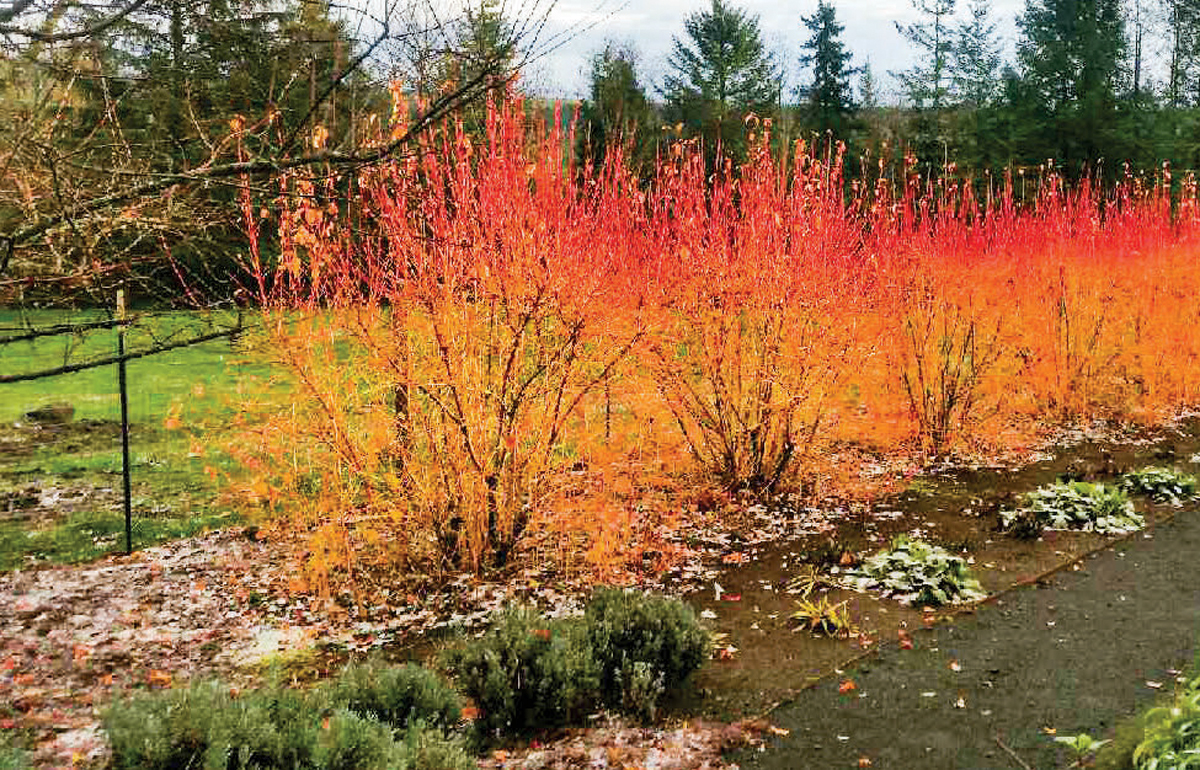
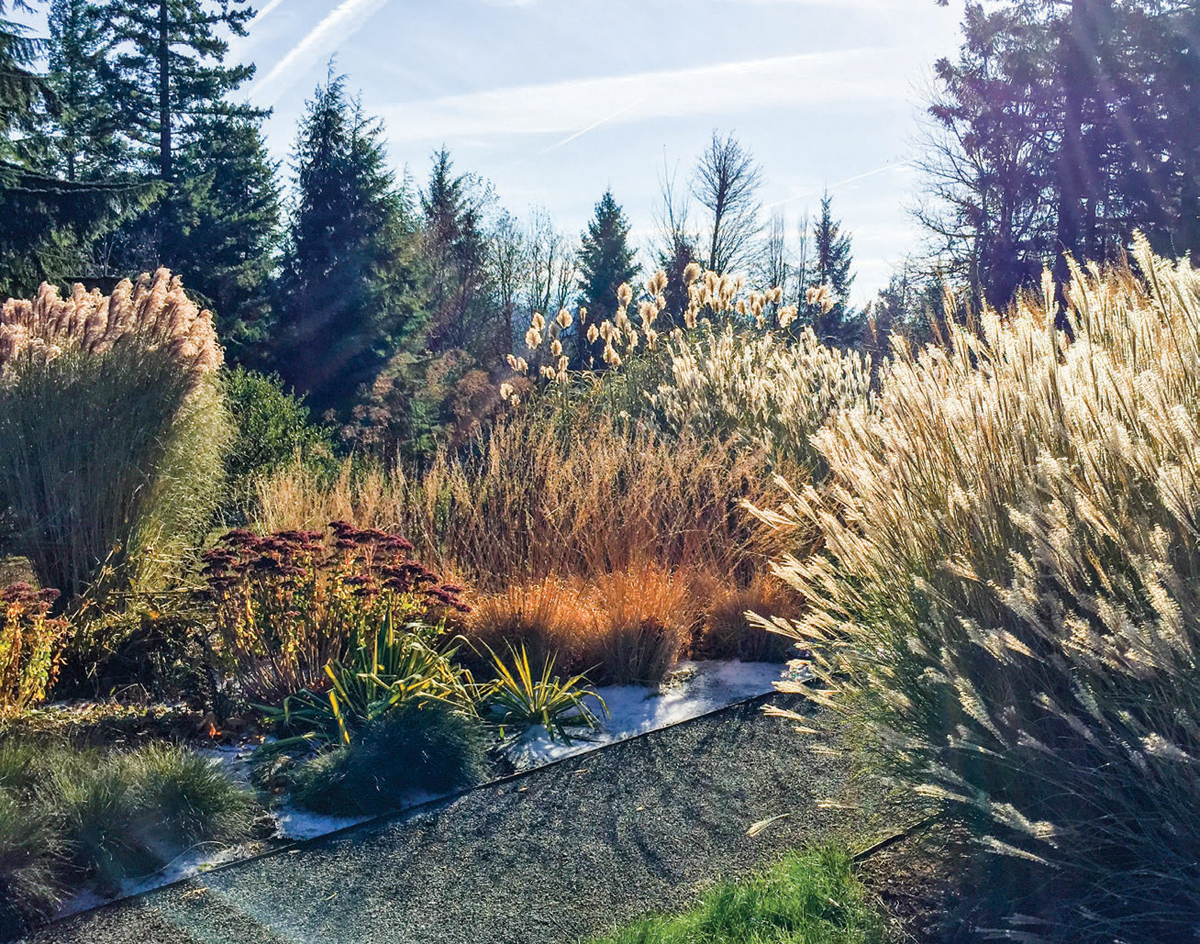
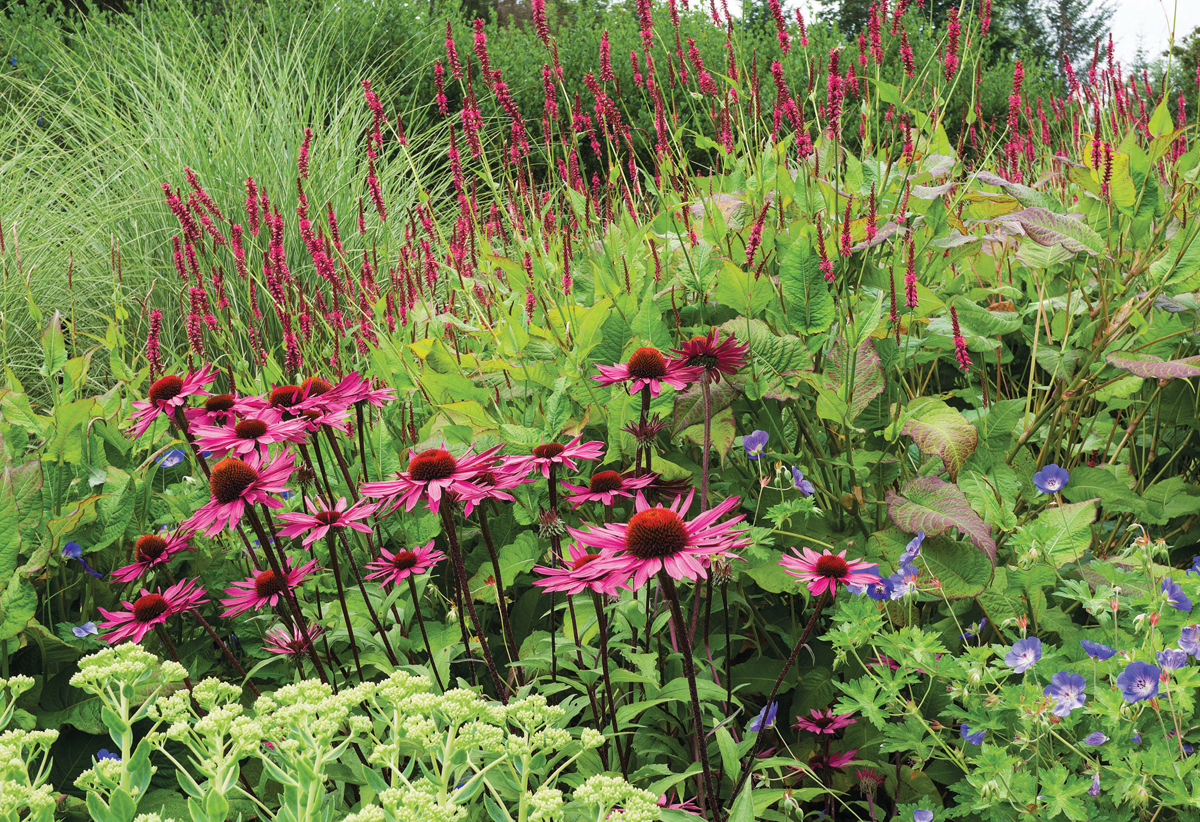

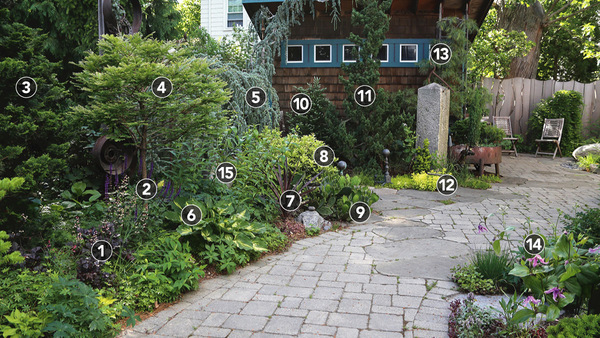















Comments
Log in or create an account to post a comment.
Sign up Log in